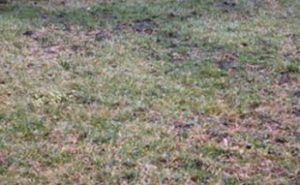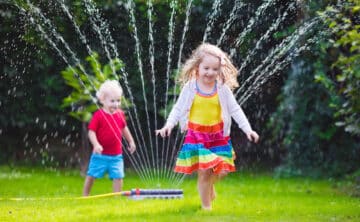Common Lawn Issues in Minnesota: Bumps, Spots & Shade
When you work so hard to maintain your lawn, you might dream of having it look perfect. In reality, even a well-maintained lawn in the Minneapolis area will never be completely free of bumps, brown spots, or bare patches caused by shade. Read our expert advice to determine what is causing your bumpy lawn, spots, or other lawn woes and how to fix them.
Managing a Bumpy, Shady, or Spotty Lawn
Whether your lawn is riddled with uneven areas, brown patches, or sparse grass due to shade, we have compiled tips on how you can restore your lawn!

Why is my lawn bumpy?
A bumpy lawn is most likely the result of typical Minnesota weather. Repeated freezing and thawing of the soil from late winter into early spring can heave the ground, creating uneven areas. Other causes of bumpy lawns include tree roots, either as a tree grows or after removal when settling occurs as the roots decompose. Some older lawns can become uneven over time as the grass thins. Typically, bumpy lawns are most noticeable in the hot, dry summer months when the ground is more firm.
Do I need to fix my bumpy lawn?
Whether to fix a bumpy lawn generally depends on personal preference. Things to consider include:
- How severe is the bumpiness? If the bumps are making it difficult to mow, or they are severe in traffic areas where someone could lose their footing and get injured, addressing them may be necessary.
- Are there other issues that need to be addressed, such as a thinning lawn? If so, a more comprehensive approach can be taken to restore your lawn.

How can I fix my bumpy lawn?
You can make minor bumps less noticeable with aeration and topdressing where needed. Topdressing, or adding a small layer of a mixture of soil, compost, and sand, is a great solution for minor cases of unevenness. Additionally, good lawn care practices, including watering, mowing, and aeration, can relieve problems associated with bumpy lawns and help keep them from occurring in the first place.
If there are major bumps or holes in your yard, you will need more labor and materials.
For larger raised areas
For larger raised areas and bumps that extend above the turf, you’ll need to cut back the turf and remove soil underneath. The turf can then be placed back on top of the lowered area. Proper watering, so the roots can reestablish, is advised.
For larger low spots
For larger low spots and holes in your yard, fill with topdressing–-a combination of topsoil, compost, and sand. If the low spot is less than an inch deep, spread your fill matter approximately ½ inch deep at a time. Repeat this process as needed over time to allow the grass to establish itself at the new height. If there is a larger hole, the turf can be cut out, the hole filled with soil, and the turf replaced at the new height.
What causes brown or yellow spots in my lawn?
Brown patches in your lawn and a yellowing lawn are common issues, and they can be caused by a number of reasons:
- Dog spots – the nitrogen content of the urine can cause your grass to turn yellow where they choose to “go.” (To learn more, check out this article from McGill University.)
- Salt damage – salt used on the roads or your driveway can leave brown spots.
- Diseases – lawns are susceptible to both cool weather and warm weather diseases, which can cause unsightly patches in your lawn.
- Insects – grubs and other pests can cause harm to your lawn as they feed on the grass roots.
- Drought – if you’re seeing large brown spots, lack of water – or improper watering practices – could be the problem.
What can I do about brown or yellow spots in my lawn?
Soil testing is recommended as a starting point. If you are not within our Minneapolis-St. Paul service area, soil testing is generally available through local agricultural extensions at a nominal fee. Determining the cause of your lawn spots is the first step in identifying a solution!
Why can’t I get grass to grow in the shade?
In general, shade and grass do not work well together. Even grass species designed for shaded areas need a minimum of 4 hours of sunlight per day to remain healthy. Without adequate sunlight, you will have thin and straggly grass growth combined with bare patches. There will often be an added problem as shade-loving weeds fill the bare spots. Additionally, traffic from pets, children, and mowing negatively impacts lawns with shade.
What can I do with shady areas in my lawn?
Grass seed will germinate but will not provide lasting turf without enough sunlight. If you desire a lawn in shady areas, it will require yearly seeding. Additionally, if trees are the cause of deep shade, pruning to thin the tree canopy is one option. Alternatives to establishing grass in a shady area include:
- Mulching deeply shaded areas, including the north side of buildings and under trees
- Planting shade-tolerant ground cover
- Establishing a low-maintenance garden with Minnesota shade-loving perennials such as hostas, astilbe, and coral bells
Adjust your watering in the shade
Water evaporates more slowly in the shade. Excess watering can create problems for shady areas as they don’t have a chance to dry out sufficiently. Additionally, wet, shaded conditions can create favorable conditions for lawn diseases. Be sure to water accordingly!
Still not sure how to handle your bumpy, spotty, or shady lawn?
If you’re within our Twin Cities metro lawn care service area, contact us to schedule your consultation today! A Rainbow licensed lawn care technician will identify what’s causing your lawn problem and give you the best solution for a thicker, healthier, and greener lawn.
Other items you may be interested in:

Mowing Tips for Minnesota Lawns
Mowing your Minnesota lawn can seem like a daunting task. It can be time-consuming, requires owning and maintaining equipment, and small details like grass length

Spring Lawn Care Checklist for Minnesota Yards
At the first sign of spring in the Minneapolis & St. Paul area, many of us are ready to pounce on our yard and get

Tips for Watering Your Lawn in Minnesota
Why is watering your lawn important? Most living things require water to thrive, and your grass is no exception.



